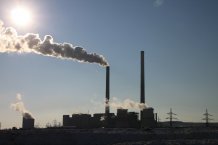Articles

The new president and his team are revising the social cost of carbon, a decade-old cost-benefit metric used to inform climate policy by placing a monetary value on the impact of climate change.
Experts offer roadmap for Biden administration to calculate social cost of carbon in new analysis
The Biden administration should reinstate the estimated economic cost of CO2 emitted to $50 a ton, a group of leading researchers has said.
The new president and his team are revising the social cost of carbon, a decade-old cost-benefit metric used to inform climate policy by placing a monetary value on the impact of climate change.
In a newly published analysis in the journal Nature, a team of researchers lists a series of measures the administration should consider in recalculating the SCC.
The revised SCC will be created by the federal government’s Interagency Working Group (IWG), which includes the Council of Economic Advisors, the Office of Management and Budget, and the Office of Science and Technology Policy.
In the journal Nature the experts, including Professor Ben Groom from the University of Exeter Business School, list several recommendations for the IWG to consider in devising the new SCC. These include:
- Reinstating the estimated economic cost of CO2 emitted to $50 a ton, which the Trump administration lowered to $1-7 a ton
- Updating the damage functions that tally how climate change affects human welfare, from crop losses to heat impacting student learning and worker productivity
- Incorporating the inequitable effects of climate change by within and across countries
- Reviewing discount rates, the ways in which the cost of future climate-related damages are priced in today’s dollars in order to better inform today’s budgetary processes
- Updating forecasts for both economic and population growth—both of which affect predictions of emissions and related environmental impact
- Include the impacts on biodiversity and ecosystem services in the analysis of climate damages
“Climate science and economics have advanced since 2010,” the authors say. “Devastating storms and wildfires are now more common, and costs are mounting. Advances in science mean that researchers can now link many more extreme weather events directly to climate change, and new econometric techniques help to quantify dollar impacts.”
Professor Groom said: “The Trump administration slashed the price of carbon for regulatory analysis from US$50 to US$1/tCO2 by deciding that climate damages were not an “America First” concern if they occur overseas or affect future generations.
“We propose an immediate reversal of this decision and call for a return to the scientific approach to climate change economics, building on the foundational work of the Obama era. We are constantly finding out new things about climate change, and there is much to learn. Our 8 point research agenda aims to guide future research. We hope it will inform inclusive and politically viable policy in the US as it re-joins the Paris Agreement, and beyond in the run up to COP 26.”
Gernot Wagner, a climate economist at New York University’s Department of Environmental Studies and NYU’s Robert F. Wagner Graduate School of Public Service and the paper’s lead author, said: “President Biden signed a Day One executive order to create an interim SCC within a month and setting up a process to produce a final, updated SCC within a year.
“Our work outlines how the administration can use the latest research in ways that take into account storms, wildfires, and other phenomena that are more devastating today than they were when the SCC was first created.”
“The damage and loss of life caused by the severe weather in Texas is only the latest example of how climate change can upend our well-being in ways not imagined only 10 years ago.”
The article was also authored by academics from the University of California at Berkeley, the University of Maryland, the London School of Economics and Political Science, Yale University, the University of Wisconsin-Madison, and Harvard University.
Date: 19 February 2021
